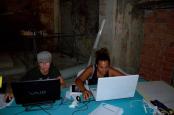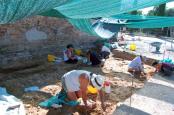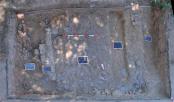CAMPAGNA 2011 |
1° SETTIMANA |
2° SETTIMANA |
3° SETTIMANA |
4° SETTIMANA |
5° SETTIMANA |
6° SETTIMANA |
17 AGOSTO 2011 
Resoconto della giornata di scavo
Area 1000
Sta continuando la rimozione dei resti scheletrici US 1089 e la messa in evidenza della struttura muraria US 1018 che si e' dimostrata larga 52 cm, contro i 62 dell'altra struttura US 1008. La pulizia ha inoltre evidenziato due riempimenti (US 1105 e US 1106), probabilmente relativi a due buche relazionabili a quelle già presenti nell'area e relative a fasi di cantiere di età recenti. Abbiamo proceduto con la rimozione dell'US 1097, costituita da pietre di piccole dimensioni. Al di sotto di questa si e' rivelata una struttura composta da pietre di grandi dimensioni e laterizi, probabilmente riferibile ad una canaletta di deflusso delle acque che sembra procedere sotto la fondazione dell'abside.
Today we began
by exposing more of the north wall feature (US 1018), as well as a
structure made of large stones and bricks (US 1104) coming from under
the apse of the church which may indicate the evidence of a possible drainage
system. We also continued removing skeletal elements from the newly expanded US
1090. We finished by excavating three holes (US 1105, 1106,
and 1087) resembling those we have excavated previously and may be
indicative of relatively recent building structures.
Area 2000
Continua l’indagine nei diversi settori che caratterizzano l’intera area in vista della conclusione della I campagna di scavo.
Us 2108 and 2118 were put into the GIS today. These skeletons were removed yesterday. Us 2140, 2131 and 2137 were fully exposed, documented and photograped. Tomorrow Us 2140, which is the individual directly below Us 2137, will be exposed.
***
Today we worked on incorporating skeleton 2118
into the GIS program. It is a very important program because it gives a really
precise drawing of the skeleton and therefore preserves the position of each of
the bones in the skeleton as data. The skeleton was rectified and georeferenced
in the GIS program and at this point all of the skeleton has been drawn in
except some parts of the skull. Skeleton 2118 is a very interesting case for a
number of reasons. Through analysis of the pelvic region, the muscle attachment
sites, and shape of the mandible it was determined that the individual was a
male. A number of the joints, especially the hands and feet, show osteophytic
lipping, most likely associated with arthritis. The right pubis and both ishial
tuberosity display a lot of osteophytes as well. This indicates that the
individual was likely over the age of 40. The spinal column shows signs of a
quite severe spinal disease, as many of the lumbar and thoracic vertebrae are
fused. Closer examination of the vertebrae is needed to narrow down the
diagnosis of the type of spinal disease that may have caused this. It is hard
to tell if the disease affected the cervical vertebrae since they were very
fragments and many had been pushed up into the cranium before excavation. From
the fragments though it seems as if the cervical vertebrae were not as affected
by the disease though as none seem to be fused or have lipping as extensive as
lower vertebrae. A rosary was found in the left hand of the individual with the
beaded chain still intact. A medallion was found under the left shoulder of the
individual as well. Three buttons were found over the pelvic region.
Area 3000
La rimozione degli strati UUSS 3062 e 3063, estesi nella porzione meridionale dell’area, ha permesso di mettere in evidenza due nuovi orizzonti stratigrafici, UUSS 3083 e 3084 ed il ritrovamento di alcuni oggetti votivi in bronzo, tra cui una medaglietta di forma circolare con la raffigurazione di San Nicola e della Madonna di Loreto. US 3083 è uno strato a matrice limo-argillosa di colore giallastro ed è localizzato a sud della struttura muraria US 3073; US 3084 è invece a matrice sabbio-limosa, ricco di macerie e di ossa umane non in connessione anatomica, localizzato nella porzione centrale dell’area, in corrispondenza di US 3073. Entrambi gli strati sono tagliati da alcune buche di forma sub-circolare, UUSS – 3075, - 3077 e – 3079. In particolare US – 3075, di grandi dimensioni, è localizzata immediatamente a nord di US 3073; UUSS – 3077 e - 3079, rispettivamente a sud del muro medievale e nell’angolo sud-orientale dell’area, intercettano una sepoltura orientata nord-sud, anteriore al XVIII secolo, che si estende lungo la facciata della chiesa ed in parte al di sotto di essa. Lo svuotamento della fossa US – 3075 ha inoltre permesso il ritrovamento, oltre di numerosa ossa sparse, di una croce in bronzo con conservata parte della catenina che doveva probabilmente far parte di un rosario.
Today on 17.08.2011 we cleaned up layer 3063
and found a religious medallion and some human bone fragments. During the
cleaning we discovered a cut in the central eastern part of the area. The cut
turned out to be a pit that contained a large quantity of fragmented human
bone, a well preserved rosary and rusty nails. While that cut was being
uncovered another cut was found in the southern boundary of the area. When
excavating the fill of the cut we discovered it cuts into a part of a burial
containing well preserved human remains, possibly 17th century, but
since this is our last week we cannot start excavating them due to time
constraints.
Area 4000
Data la scoperta degli ultimi giorni riguardante la struttura probabilmente afferente al chiostro della Abbazia di S.Pietro (US 4062) ed il suo relativo crollo (US 4063) è stato deciso di evitare ulteriori interventi che potrebbero lasciare lo scavo di importanti stratigrafie interrotto. Una volta documentata l’attuale situazione è stato dunque iniziato lo scavo del settore meridionale dell’area, rimasto non indagato per concentrare gli sforzi sul settore meridionale. La giornata di oggi è stata dunque incentrata sullo scavo di questa zona, che probabilmente confermerà l’andamento della struttura e dei tagli sino ad ora rilevati (US -4012 ed US -4048), verso sud.
Today we continued
working on the new found wall. We determined that the slates near the wall are
a part of a destruction layer. We cleared and cleaned the slates, took a
pictures, elevations and total station measurements. After the measurements we
filled out context sheets for the wall, slates destruction layer and a few
other contexts. We then destroyed a large of 4017 to reveal the rest of
the wall.

















